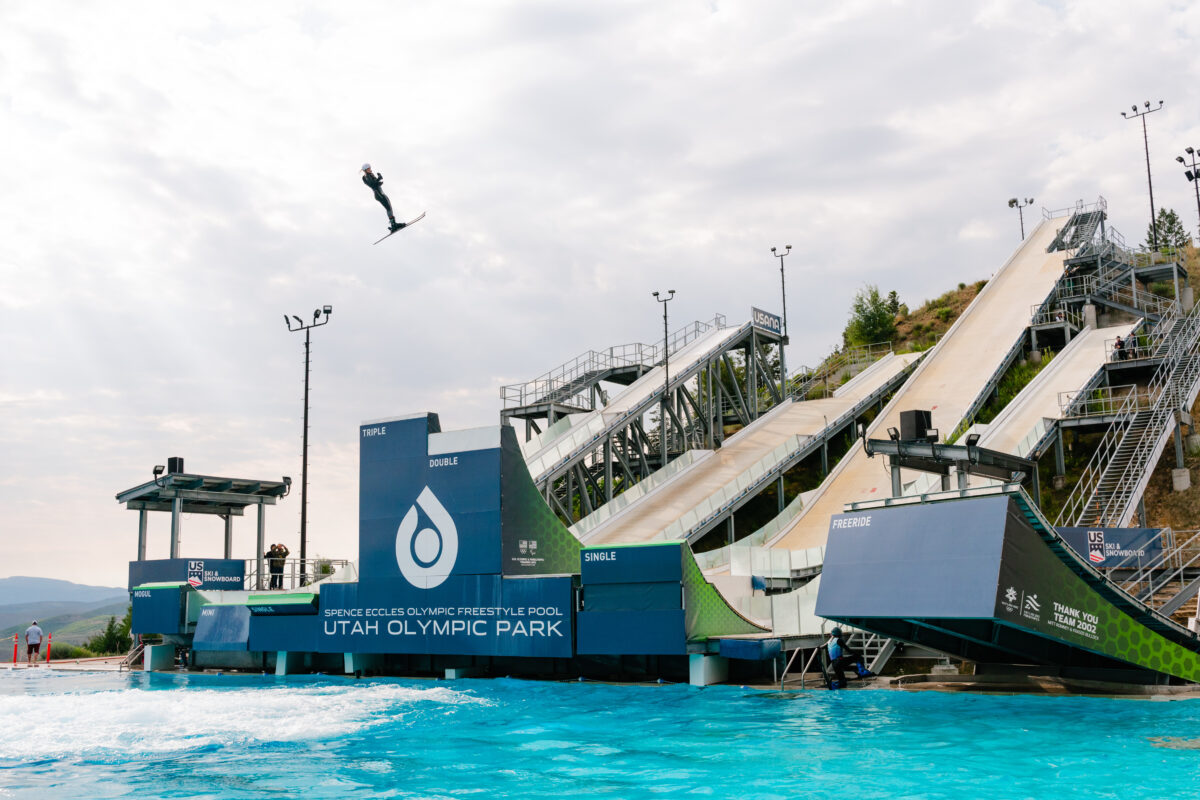When your sport features snow or ice and you have to train all throughout the year to be an elite athlete with hopes of making the Olympics, what do you do in the summer?
For some sports with indoor venues, it’s a fairly simple solution. However, it’s a little different if athletes need snow-covered mountains or trails to train. But as freestyle skier Winter Vinecki and biathlete Jake Brown, both first-time Olympians, explained recently to For The Win, they have relatively easy options too.
In aerial skiing, athletes launch themselves off massive jumps and execute precise maneuvers, like flips of twists, in the air before trying to stick the landing on an incline. Vinecki said when doing a double, she’s going around 55 kilometers per hour before takeoff, which is about 34 miles per hour.
To practice her moves in the summer — and to learn new ones in a safer environment — Vinecki said she and the U.S. Freestyle Ski Team rely on an aerials pool at the Utah Olympic Park, training there from about May to October.
https://www.instagram.com/p/CUTP1WrJTf2/
“All summer long, the train on water ramps into a pool,” Vinecki, a 23 year old from Gaylord, Michigan, said. “So it has our jumps that go into a pool that we land it, and it has a bubble system so it softens the landing and makes it so he can see where we’re going to land easier. So [it] helps us see while we’re flipping through the air.
“And we do hundreds and hundreds on water, climbing up to the top of the metal stairs after every jump in all of our wet gear. And so this is how we practice in a little bit safer environment so that we can do new tricks.”
Climbing up stairs in wet skiing gear over and over sounds almost as challenging as the aerials these skiers attempt. But they’re not actually wearing all the same equipment compared with skiing on snow, Vinecki explained.
They’re not wearing their snow pants or jackets; they’re wearing wetsuits “and even dry suits when it’s very early season in May when the water’s still 48 degrees and then in October, sometimes, we’ve had snow when we’re so water ramping,” she said. But the rest is fairly similar to what you get on snow.
“We have our normal boots, we have our helmets, mouthguard and our skis are very similar,” Vinecki continued. “The main difference is that it has holes cut into our skis, so that softens the impact. And so, obviously, the skis we use are different, but they’re the same brand and everything and give us the same feel.”

Although practicing aerials in a pool is safer, especially when learning new tricks, messing up doesn’t exactly feel like falling on a bed of clouds.
“It doesn’t feel good if you still land on your stomach or back, but it’s at least more safe then learning on snow,” Vinecki added laughing.
For other types of skiers, like cross-country skiers, biathletes (cross-country skiing plus target shooting with rifles) or nordic combined athletes (cross-country skiing plus ski jumping), the summer training solution comes with wheels.
Specifically, roller skis. Like rollerblades but with the feel of cross-country skis.
https://www.instagram.com/p/CTLOLMaMGNO/
“They’re essentially a kind of built up shaft of ski,” Brown, a 29-year-old biathlete from St. Paul, Minnesota, said.
“Different companies make them out of different things. The most common ones are aluminum. The ones that we use are made by a Finnish company called Marwe that has a patented version that’s actually a honeycomb core — just like a cross country ski is made out of — that’s wrapped in fiberglass.”
This is the primary method for cross-country skiers training in the summer, from about May to November, Brown said. He lives in an athlete house at Craftsbury Outdoor Center in Vermont, and the property includes a biathlon range and a roller ski loop with a paved path through the woods like in cross-country skiing trails.
https://www.instagram.com/p/B2e4mQmJ-Iy/?hl=en
And while roller skiing is not exactly the same as training on snow, it gets the job done.
“It’s hard to learn to ski on roller skis and then translate that to snow,” he continued. “But if you’re used to skiing on snow, the roller skis are a great training tool. And we can ski with pretty much identical technique to snow on roller skis, so we’re training all the same muscle groups. …
“We do all our intervals and everything on roller skis [and] distance train just like we would on snow.”
[mm-video type=video id=01fv03s3rbrrgn41fznb playlist_id=none player_id=01evcfkb10bw5a3nky image=https://images2.minutemediacdn.com/image/upload/video/thumbnail/mmplus/01fv03s3rbrrgn41fznb/01fv03s3rbrrgn41fznb-5fd7d98aa524987450dc1f24eb9ff763.jpg]
[listicle id=1408347]
[vertical-gallery id=1535025]
